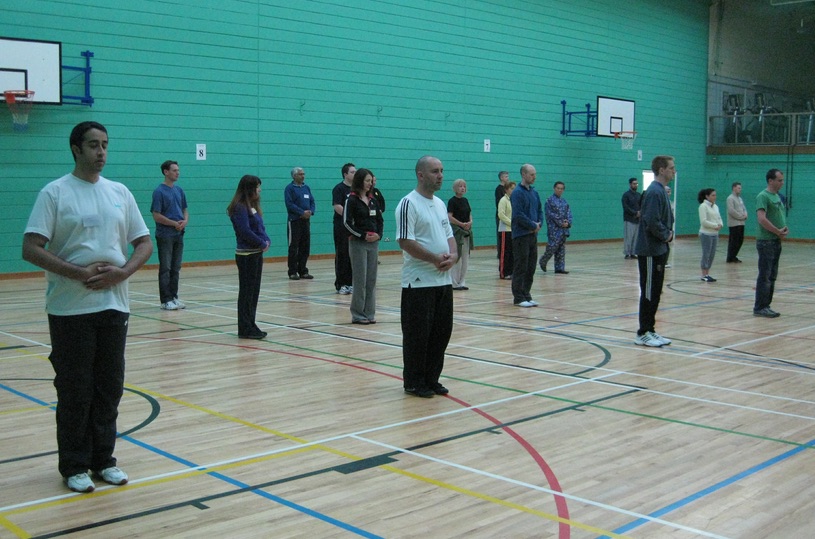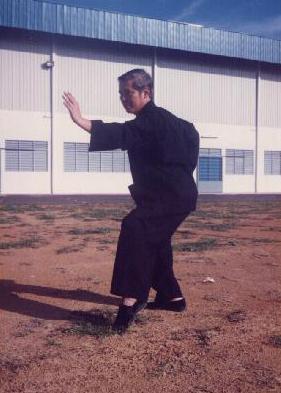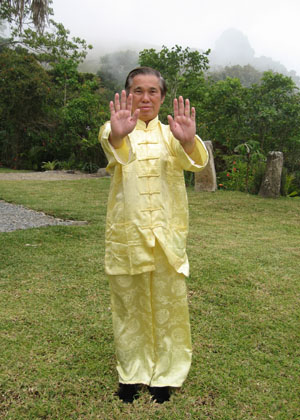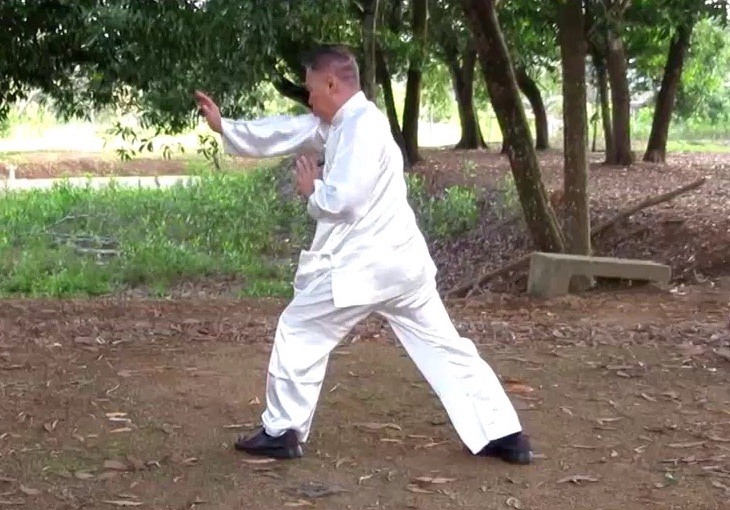SELECTION OF QUESTIONS AND ANSWERS
MARCH 2021 PART 2

Cosmic Breathing
Question 1
I've been practicing pranayama exercises with a few instructors. Pranayama is the yogic version of qigong where one uses the mind to move qi up and down the spine. The energy starts from hui yin and is traced up the spine to the third eye and back down to hui yin in a lotus posture.
— Stephen, USA
Answer
Yoga and qigong use different paradigms, though they share the same ultimate aim, i.e. being liberated into the Great Void, called differently as Brahman in yoga, God the Holy Spirit in Western culture, Original Face in Zen, and the undifferentiated spread of energy in scientific literature.The chakra system and the meridian system are also different. In the chakra system the Pingala Nadi on the right side if we face a person, and the Ida Nadi on the left are parallel to the Sushumna Nadi, which is at the center from the base to the top of the head. In the meridian system the conceptual meridian in the front part of the body, and the governing meridian at the back run round a person.
Yoga places much emphasis on "kundalini" when energy rushes up from the base to the top of the head. Many of our Shaolin Wahnam students and instructors have the "kundalini" sensation. Qigong places much emphasis on the Small Universe, where energy continuously goes round the conceptual and the governing meridians.
Question 2
However, the yogic tradition does not emphasize storing energy at the dan tian and seems to emphasize opening the rush meridian where our karmic matrix is stored. Great emphasis is placed on focusing at the third eye to open the rush meridian and allow kundalini to gently rise up.
Yoga places emphasis on the third eye for enlightenment and realization.
Can our dan tian, which is much safer to store energy, be used to attain realization? In fact, when I practice Cosmic Breathing now, I feel the same rush of bliss in my Rush Channel.
Answer
In qigong we place our energy at our abdominal dan tian, which is the center of the body. In spiritual cultivation, we can let the energy permeate the whole body in the Spiritual Big Universe where it merges with the Great Void.
Many of our students and instructors have opened their third eyes. The "third eye" is not actually an eye; it is a psychic center inside our head. At a lower level when the third eye is opened, one can understand things and events clearly, at a higher level he can see through space and time.
Opening the third eye is not Enlightenment in the Buddhist sense. In Buddhism, Enlightenment is attaining Buddhahood, or in Zen terms it is seeing the Original Face. In scientific terms it is merging with the undifferentiated spread of energy. It is the most noble of any attainment. Most humans are not ready for Enlightenment; they live happily and enjoy longevity in the phenomenal realm.
It is usual to store energy at the "dan tian", which means "energy field", even for those who do not practice qigong. There are actually many "dan tian", but when we say "dan tian" without any qualification, we mean the abdominal "dan tian". If we stand upright and are relaxed, energy will naturally be focused at the abdominal "dan tian".
Depending on our purpose, there are different ways to attain realization. But the ultimate realization, which is not suitable for most humans, is to merge with the Great Void.
When you performed Cosmic Breathing, the rush of bliss in your Rush Channel was the "kundalini" sensation.

Lohan Asks the Way
Question 3
I plan to start with the "Shaolin Kung Fu Training Programme" from the 2020 and take one month per level for the first six levels.
- January: Fundamentals of Shaolin Kung Fu.
- February: Lohan Asks the Way.
- March: Black Tiger Steals Heart.
- April: Fierce Tiger Speeds Through Valley.
- May: Happy Bird Hops Up Branch.
- June: Felling Tree with Roots.
I think that this will give me the chance to go deep and apply the skills that I acquired in your class. I will focus on picture perfect form and movement first, then slowly complicate things by substituting patterns in the sequences and build up my sparing methodology and imaginary partner.
— Brian, USA
Editorial Note:
Brian asked this question long ago, but it is released now due to a long waiting list.
Answer
If you are referring to Shaolin Kungfu Training Programme, your plan of taking one month per level for the first six levels, completing at "Felling Tree with Roots", is excellent. Your training should be systematic and progressive. In June, for example, you should not just be able to perform "Felling Tree with Roots" well, but all the kungfu sets leading to Level 6.
Regarding skills, you should follow "routine-form-flow-force". You make sure you know the routine of the set or the combat sequences, you make sure you have picture-perfect form, then you link the patterns together so that they flow smoothly, and as a result of your flow you have much internal force.
In January you focus on knowing the routine; in February you focus that you have picture-pefect form; in March and April you focus on smooth flow; in May and June you focus on internal force. The emphasis is on "focus".
In January, for example, you focus on the routine, making sure you know the routine of basic patterns, stances, footwork and One-Finger Shooting Zen. But you also spend some time, but not much, on form, flow and force.
In May and June, you do not just learn "Felling Tree with Roots", but all the sets leading to Level 6. You should have much internal force, for example, when you perform "Lohan Asks the Way" or "Happy Bird Hops up Branch".
Question 4
Then, for the following 6 months of the year July-December, I plan to travel once or twice per month to practice and spar with my Sihengs: Michael Helgeson, David Langford, Molly K, Chris/Christina Didyk (and their students), and, perhaps, even Eugene, if he is willing. This will give me a chance to regularly apply the first 6 levels of the curriculum, advancing as my skills and speed improves.
Answer
You can follow the same format -- one level per month, and focus on routine-form-flow-force -- from July to December besides visiting your classmates for sparring. You shall be able to spar quite well. Then you can change or modify your patterns and follow-through if your partner hesitates.
For example in Sequence 1, which is "Black Tiger, Black Tiger, Black Tiger", you can substitute "Black Tiger" with a palm strike at Two-Character Stance wherever you wish and whenever it is suitable. In Sequence 3, which is "Black Tiger, Poisonous Snake, Precious Duck", if your sparring partner or opponent hesitates, you can "follow-through", using your Tiger-Claw to "close" your opponent, and a "Poisonous Snake" or a "Precious Duck" to strike.

Pushing Mountains
Question 5
Happy New Year to you and your family! I hope that you have been enjoying this new year thus far. I have been enjoying my work and play tremendously.
Some of my favorite times have been attending your courses. I often find myself months or years after the courses wondering what I missed or forgot from various courses.
— Dr Fredrich Chu, USA
Answer
I am indeed happy to hear from you. Happy New Year to you. I am particularly happy to know that you have been doing very well in your work and play. Like you, life has been treating me very well.
It is great that some of your favorite times have been attending my courses. Not only you can derive much benefit from my courses, you should also spend time fraternizing with your brothers and sisters. Enjoy yourself at the places of the courses.
I know it is redundant to mention it, as I am sure you will enjoy yourself wholesomely. I am happy that our aims in Shaolin Wahnam, besides being combat efficient, have been to be healthy, full of vitality, have longevity, peak performance and spiritual joys, and help other people achieve these wonderful benefits.
I have often mentioned that if one can get one tenth of what I teach in my courses, that would be sufficient. I really don't mean to be presumptuous, but that is true. Masters -- genuine masters, and there are few today -- have been so secretive that they keep much to themselves, and only teach their selected disciples after many, many years. On the other hand, we aim for excellence; we want the best for your effort, which actually is our joy.
Question 6
I believe you mentioned that adding Pushing Mountains in Horse Riding stance was your own innovation for maintaining stability while practicing Cosmos Palm. Would you recommend that eventually Cosmos Palm practitioners convert to Pushing Mountains at Horse Riding stance rather than standing upright? If so, would we practice Holding Sun and Moon while still at the Horse Riding stance? How about exploding force with Double Dragons and Rolling Thunder? Or should we keep practicing Cosmos Palm force training the way you taught at the course?
Answer
I believe that Pushing Mountains for Cosmos Palm training, or any training, while standing upright is sufficient. But if you find that sitting at the Horse-Riding Stance gives you more benefit, you can try it.
For beginners Pushing Mountains while standing upright is recommended. If they sit at the Horse-Riding Stance, they may not be able to get chi flowing at their arms.
Holding Sun and Moon should be practiced while standing upright. The purpose is to get chi flowing. Sitting at the Horse-Riding Stance is to focus chi at the dan tian.
If we want to focus on energy flow while exploding force, for Cosmos Palm or any other exercise, we should stand upright. If we want to focus on consolidating energy while exploding force, we should sit at the Horse-Riding Stance. The Two-Character Stance, as I discovered through experience, is when flowing energy has become consolidated at the dan tian. The Goat Stance is somewhere in between.

"Single Dragon Emerges from Sea" from Cosmos Palm looks prosaic, but in the hand of a master, this technique can be very formidable
Question 7
My practice of Forceful Big Windmill has changed a little bit over the past few years. At the beginning, while moving my arm in a circle, I felt a lot of force along my entire arm and hand and sometimes my arms would vibrate rather wildly as I consolidated the force. Lately, I feel more force near the end of my forearm, my wrist, and my palm rather than along my entire arm.
I also remember that at the Cosmos Palm course, you recommended we focus our energy at our palm after Forceful Big Windmill when we were preparing to attempt to break bricks. Should I be focusing the force developed from Forceful Big Windmill at my palm in a purposeful manner, or just let the exercise happen naturally? Are there any other fine points you would recommend we keep in mind while practicing Forceful Big Windmill?
Answer
Congratulations for your experience in the practice of Forceful Big Windmill. You are attaining the stage where you can explode force from your wrist at short distance. Not many masters have attained that.
I taught at the Cosmos Palm course what I learned from my sifu, Sifu Ho Fatt Nam. I am very grateful to my sifu for teaching me this secretive art.
It is best to let the exercise, for force development from Forceful Big Windmill or any exercise, happen naturally after we have learned the techniques. Learning the techniques is important, though skills are generally more important. But when we have learned the techniques skilfully, we let the exercise happen naturally. This will allow energy to flow to where it is needed most.
One reason why can learn very fast is we understand its philosophy. In force development from Forceful Big Windmill, for example, we understand that we must first let energy flow. Then we consolidate the energy into internal force. It was through many years of experience and some intelligence that I understand this, and I share it with deserving students.
Question 8
Does there happen to be a "nemesis" to Cosmos Palm application or force? If there is not a specific nemesis art or kung fu style to Cosmos Palm, how would Sifu choose to best combat a practitioner of Cosmos Palm?
Answer
There is no nemesis for Cosmos Palm. In Wing Choon Kungfu, for example, the nemesis is chin-na, or qin-na in Romanized Chinese. Hence most Wing Choon masters know how to neutralize chin-na. Many Wing Choon practitioner, or they call themselves Wing Choon practitioners, do not know simple Wing Choon techniques, and they bounce about like Kick-Boxers when they have to fight.
I would like to remind our Cosmos Palm practitioners to be relaxed when training Forceful Big Windmill. In fact one should be relaxed and focused, or in a state of Zen, in training any internal force.
The best way to combat a Cosmos Palm practitioner, of any practitioner, is to be relaxed and focused. Basically it comes down to skills.
There are 3 basic levels:
- Do not give away advantages. i.e. cover your opponent well.
- Exploit advantages given by an opponent unknowingly.
- If there are no advantages, create some yourself.
Editorial Note:
Dr Fredrich Chu's questions are continued at March 2021 Part 3.
LINKS
Selected Reading
- Sifu Wong's Personal Experience during Chi Kung Practice
- Small Universe and Shaolin Cosmos Chi Kung
- Baguazhang -- Overview
- The Weakness of Double Yang
- Arrival at Chennai, the Old Madras
